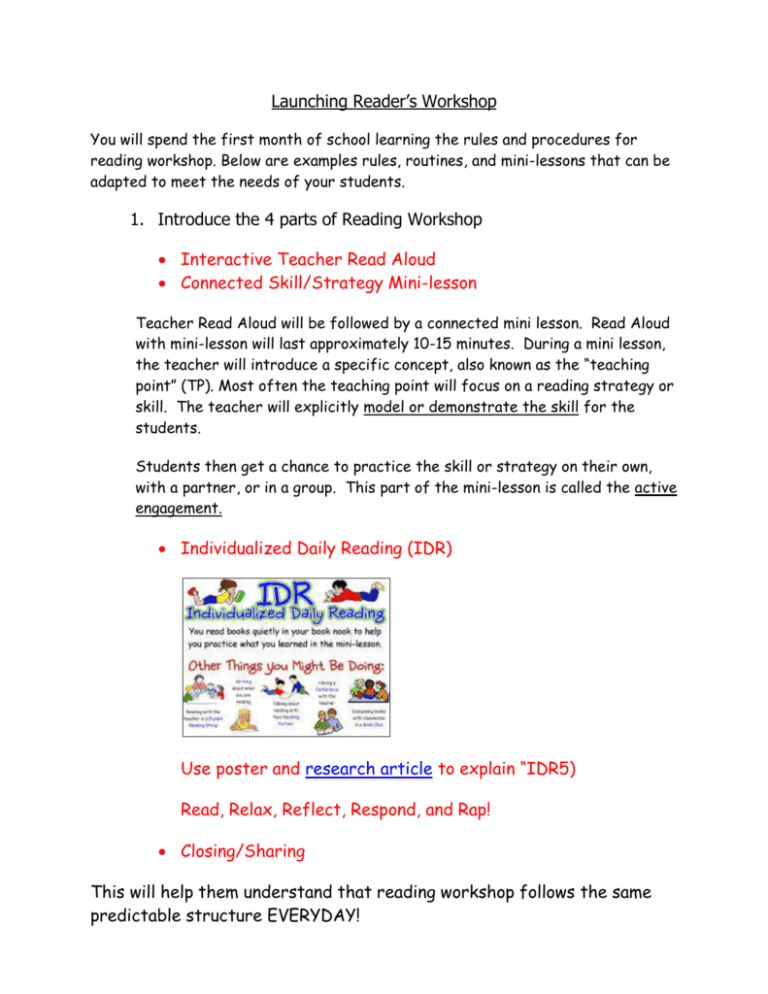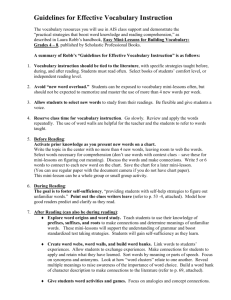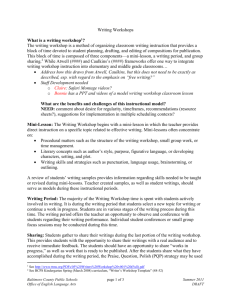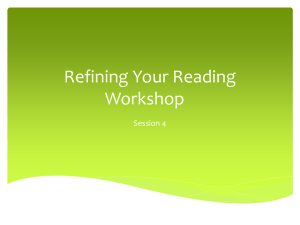Launching Reader`s Workshop
advertisement

Launching Reader’s Workshop You will spend the first month of school learning the rules and procedures for reading workshop. Below are examples rules, routines, and mini-lessons that can be adapted to meet the needs of your students. 1. Introduce the 4 parts of Reading Workshop Interactive Teacher Read Aloud Connected Skill/Strategy Mini-lesson Teacher Read Aloud will be followed by a connected mini lesson. Read Aloud with mini-lesson will last approximately 10-15 minutes. During a mini lesson, the teacher will introduce a specific concept, also known as the “teaching point” (TP). Most often the teaching point will focus on a reading strategy or skill. The teacher will explicitly model or demonstrate the skill for the students. Students then get a chance to practice the skill or strategy on their own, with a partner, or in a group. This part of the mini-lesson is called the active engagement. Individualized Daily Reading (IDR) Use poster and research article to explain “IDR5) Read, Relax, Reflect, Respond, and Rap! Closing/Sharing This will help them understand that reading workshop follows the same predictable structure EVERYDAY! 2. Students are introduced to the concept of “Book Nooks” After reading books like A Quiet Place by Douglas Wood, students selected places in the classroom that felt "just right" for independent reading time. Readers begin trying out different places in the room in hopes of discovering the "best place" to read. Since a couch, soft chair, large pillows, dish chairs, and bean bags are popular places to read, you may want to have a "book nook" rotation chart that is changed by a “classroom librarian” each day after reading workshop is over. http://hill.troy.k12.mi.us/staff/bnewingham/myweb3/reading%20workshop%20launching.htm (KIS student pics coming soon!) 3. Mini-lesson on choosing “Just Right Books” You can use the “Five Finger Rule”: Read the first page of the book. For each word you don’t know, put up one finger. At the end of the page, if you have five fingers up, then the book is too hard. If no fingers are up, the book is too easy. You will have 2 or 3 fingers up for a “Just Right” book. By using this method you can independently choose an appropriate book. You can also compare a "just right" book to a shirt that fits perfectly. An oversized shirt and/or a shirt that is too small are not very comfortable to wear. Use that idea as an analogy for books that are easy or challenging. http://hill.troy.k12.mi.us/staff/bnewingham/myweb3/reading%20worksho p%20launching.htm 4. Introduce Book Boxes All students have a book box in which they store the books that they individually select from the classroom library. Students keep multiple books in their boxes. Students take their book box with them to their book nook while they are reading. Inside the book box, students also keep sticky notes, pencils, and bookmarks. All book boxes should be stored on a special shelf in your classroom that holds both the book boxes and students' Reader's Notebooks. When selecting books, students make sure to put enough books in their book box so that they do not have to spend time switching books during IDR (students should switch books no more than twice a week.) http://hill.troy.k12.mi.us/staff/bnewingham/myweb3/Book%2 0Boxes.htm (KIS student pics coming soon!) 5. Establish Class Rules and Routines After spending a week in the reading workshop, students will be familiar with the routine and will be ready to establish rules and routines. Your class should agree upon a list of rules that all readers should follow in order to make the workshop time most beneficial and enjoyable for all readers. http://hill.troy.k12.mi.us/staff/bnewingham/myweb3/reading%20workshop%20launching.htm (I’ll be looking for KIS pics!) 6. Set-Up Reader’s Notebooks Students use their Reader's Notebooks to: Record books they've read Keep track of the genres they are reading List books they would like to read in the future Respond to their reading Prepare for book talks Keep track of Partner Reading discussions and meeting times Maintain Self-monitoring checklists (See Reader’s Notebook page for blackline masters of student forms and possible guidelines for notebooks. Teachers should set up notebooks based on classroom/student needs.) 7. Continue Mini-Lessons to “practice” workshop procedures and forms These are possible Mini-lessons that will help continue “launching” your Reader’s Workshop. Specifics for each of these lessons can be found on the Mini-Lessons page. Reading Genres: As students record books in their reading logs, they are expected to categorize the books by genre. Since many students are unfamiliar with this concept, they are introduced to each of the different categories during Reading Workshop mini-lessons. Bag O’ Books: Homework Extension Overall Reader’s Workshop Classroom Management: Webpage summary of management tips Book Recommendations: Ways students can share books with others Reading Partnerships: Procedures for partner reading Literature Circles: Guidelines for meeting in Lit Circles Thick and Thin Questions: Levels of questioning Interactive Reading Activities Class Book Awards: A fun, interactive way to celebrate favorite books Theme Studies: Multiple mini-lessons that connect books to themes Reading Detectives: Mystery Genre Unit











